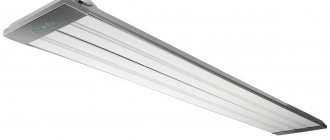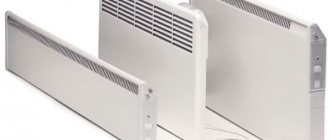Choosing a heater for a garage without heating often becomes a serious problem for car enthusiasts who are accustomed to repairing their car in comfortable conditions even during severe frosts. The problem is that there are currently so many offers on the market that choosing a conventional garage heater turns into a lottery for the buyer with an unknown result. Therefore, before going to the store, a car enthusiast should understand the types of heaters, and also learn to calculate the required power of the device in order to choose the best option for his garage from the four most popular modifications presented in this article.
Diesel fuel appliances
If the garage is located far from the house, then its owner should think about buying a diesel heat gun. The operating principle of such an installation is practically no different from electrical appliances, but in this case the air is heated due to fuel combustion.
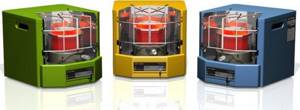
There are quite a lot of advantages of such heaters:
- quickly warm up the room and automatically maintain the set temperature;
- distribute heat evenly over the entire area;
- allow you to save on heating by using diesel fuel instead of electricity.
Among the disadvantages of such equipment, experts highlight:
- quite high cost of devices;
- the mandatory presence of electricity, which is necessary for the fan to operate;
- an environmental factor, since when diesel fuel is burned, oxygen burns out, and combustion products harmful to health enter the room.
Therefore, in small garages it is recommended to install an indirectly heated diesel gun/boiler, where the combustion chamber is reliably isolated from the convector, and there is a separate outlet for removing harmful substances.
Rules for operating different types of heaters
So, we have looked at the main types of heating systems for heating in the garage. Now regarding the rules for operating such equipment.
Since the most common option is electric heating systems, let’s figure out how to use them as safely as possible:
- first of all, you should make sure that all electrical wiring is in good condition and the sockets can withstand the voltage of the heating device;
- If the humidity in the room increases, the risk of a short circuit increases, so this issue should be taken seriously and prevent sudden temperature changes in the garage.
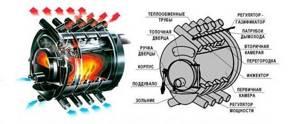
If we are talking about the operation of diesel or gas heaters, then you should pay attention to the following nuances:
- the possibility of gas leakage or gasoline evaporation;
- the need to take enhanced fire safety measures;
- organization of ventilation and removal of combustion products.
Well, the owner himself decides how best to heat the garage. It all depends on the capabilities and goals pursued by the motorist.
Use of liquefied gas

Equipment of this type is practically no different from the previous version, but its operation is associated with increased safety measures, since normal operation of the installation requires a connection to a propane cylinder, and during operation of the heating device, oxygen quickly burns out and combustion products enter the room. To this list it is worth adding strong noise and a powerful fan that can raise dust into the air in the room.
Therefore, heat guns running on liquefied gas are not recommended for use in rooms where people are constantly present or working.
Basic criteria for choosing a heater for a garage
Oil, gasoline and other flammable liquids are typically stored in the garage. Therefore, when choosing a heater, special attention should be paid to safety.
Oil-based ones are considered the safest, but they take a long time to warm up and heating the room to normal temperature will also take a long time.
Heat guns will do the job much faster. They are equipped with a coil that heats up in a matter of seconds and a fan that immediately begins to distribute heat in the room. However, such heaters are less safe and require proper location: there should be no flammable substances nearby, and the heaters themselves cannot be covered with anything.
In any case, each heater must have the necessary certificates confirming the safety of the unit.
An important characteristic is the power consumption of the heater; in most of them at maximum operating mode it is 2000 W.
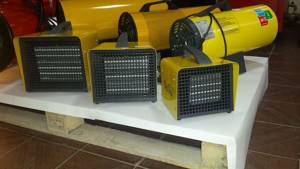
Electrical devices
One of the most popular types of garage heaters. All equipment of this type can be divided into three groups:
- Oil radiators. Among the advantages of such heating devices are: safe operation, relatively low cost, increased heat transfer due to a large heated surface area, resistance to mechanical damage and sudden voltage surges, a large selection of models. The disadvantages of electric heaters are considered to be rather long and uneven heating of the room, as well as significant energy costs. For garages, experts recommend buying models equipped with automatic overheating and tip-over protection, a timer and a thermostat (the latter is optional).
- Convectors. The operating principle of this type of heaters is based on the natural circulation of air that passes through the heating elements. The main advantages of convector heaters are: resistance to breakdowns due to their simple design, safe operation, simple installation, and the ability to maintain a given temperature. Among the disadvantages of such equipment, we can only highlight the rather long heating of the room and labor-intensive maintenance - from time to time the device has to be disassembled to clean it from dust.
- Fan heaters and guns. Mobile heaters of this type are inexpensive. But they heat the air quickly and evenly (over the entire area), practically do not burn oxygen, and are able to maintain the temperature in the room automatically. Of course, there are also disadvantages, but there are very few of them - relatively high operating costs due to electricity consumption, quite loud noise during operation and frequent maintenance and replacement of consumables in the form of an input dust filter.
- Heating cables. This type of heating has many advantages - economical and efficient operation, uniform and quick heating of the room. However, most owners refuse this method of heating their garage because the work of arranging a heated floor is too complicated.
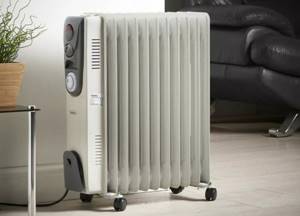
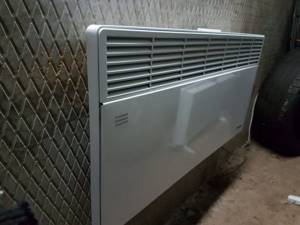
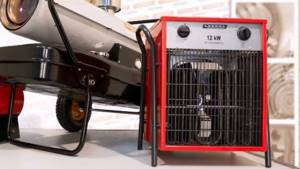
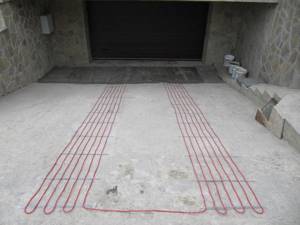
The purchase of heat guns will be justified only if the garage has reliable electrical wiring with a rated voltage of 380 Volts. Therefore, in practice, combined options are more often used, in which the convector runs on liquid fuel and the fan runs on electric current.
Requirements for energy-saving heaters
To install energy-saving heaters, you must familiarize yourself with all the requirements. Below are the operating rules:
- Before installation, you need to determine the minimum electrical energy consumption to generate one unit of heat.
- Fire safety. According to this rule, the requirements for all heating devices remain unchanged.
- Electrical safety. The heating device will operate around the clock, so garage owners must ensure that the wiring is intact.
- Easy maintenance during operation. It is necessary to perform preventive inspection and maintenance of the device at certain intervals.
Important! Electric heaters are attractive due to their mobility.
They can be moved around the room during renovation work.

Heaters must be safe to use
Infrared heat
A separate type of garage heaters that appeared relatively recently. The emitter of this device first heats objects in the room, which then heats the air. For garages, it is recommended to use relatively cheap electric IR heaters with aluminum emitters. The maximum temperature of aluminum heating elements does not exceed 300 degrees, which complies with fire safety rules and virtually eliminates oxygen burnout.
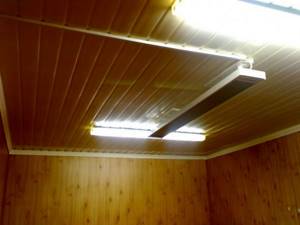
IR-type units operating on gas and liquid fuel are not recommended for heating garages, especially small ones, due to safety reasons.
The use of IR devices allows the garage owner to set up full or partial heating of the technical room, including in hard-to-reach places. However, equipment of this type is more suitable for maintaining a given temperature, since heating of the air in this case occurs rather slowly.
In addition, when choosing an infrared heater for a garage, special attention should be paid to the thickness of the anode layer (at least 25 microns), and you should not buy a device if its body is not made of stainless steel.
Which garage heater should you choose?
When choosing a heater, special attention should be paid to the area of the room for which it is purchased. It is not beneficial to use a high-power heater in a small room. This will lead to increased energy consumption. Also, you should not take a low-power heater for large hangars: they simply will not be able to heat a large room.
For small garages, the best option would be heat fans, which heat up quickly enough and immediately fill the room with warm air. For example, RESANTA TEPK-2000K (2 kW).
For larger garages (from 20 sq.m.), it is better to purchase an infrared heater. For example, Ballu BIH-L-3.0.
For large hangars containing several vehicles, the best option would be the Sibrtech GH-10 (10 kW).
If you want to save money, it is better to purchase a gas heater. They are considered more economical and safe. Among those presented is the Timberk TGH 4200 SM1.
Gas
Gas heaters are a fairly convenient option that quickly pays for itself. They usually operate on a propane-butane mixture and are connected to a liquefied gas cylinder. In turn, the gas heater is divided into two versions: convector and ceramic.
- A convector gas heater is a combustion chamber that is connected to a gas cylinder. The device is also equipped with an air duct that supplies air for, and a chimney for getting rid of combustion products.
- The second version of the gas heater is ceramic models. They heat ceramic panels built into the device.
One of the advantages of this model is the combustion sensor. If the flame goes out, the heater will stop supplying fuel - this makes a ceramic heater safer.
If there is access to a common gas pipeline, then the ceramic version has a universal valve for connection. In addition, the gas appliance has a thermostat that allows you to regulate the air temperature: this also saves fuel.
A gas heater is best suited for heating garages that do not require constant heating.
Calculation of the thermal power of the heater per square footage of the room
The thermal power of the heater, which is necessary to maintain a warm temperature in the garage, is calculated using the formula.
The volume of the garage space (V = width x length x height) is multiplied by the difference between the required air temperature inside the garage and outside (Δt) and multiplied by the heat dissipation coefficient (K). The number K in the formula is not constant and depends on the type of insulation in the garage and the structure itself.
The result is a number (N) that corresponds to the recommended thermal power of the device.
The best thermal curtains for the garage
Thermal curtains are placed above the doorway, on its sides or in the floor (depending on the configuration). They block the penetration of cold into the room, creating a powerful flow of hot air.
Timberk THC WS2 2.5M AERO
Rating: 4.9
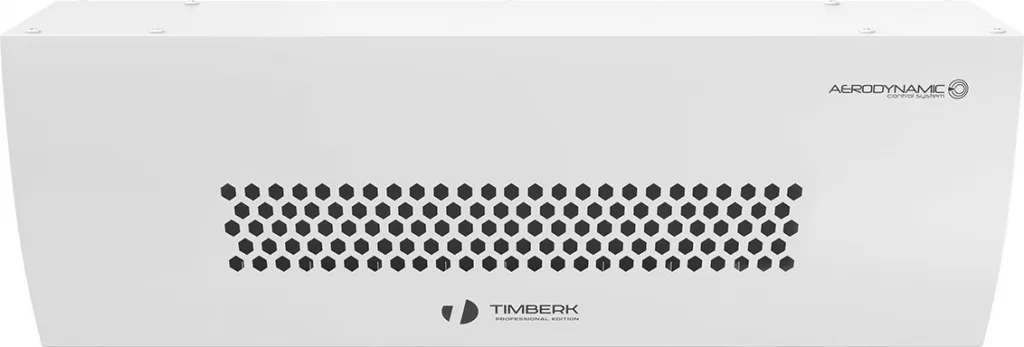
Thermal curtain with a needle heater, power 2500 W. It has a wide panel with perforation, from where a strong flow is supplied with an air exchange of 240 m³/hour. The heater has a mechanical control with a thermostat. Ventilation can be started separately from the heating element. The curtain is installed on the doors, where the recommended maximum height is 2.2 m. When overheating, protection is triggered. The heater weighs only 4 kg. The manufacturer promises 7 years of operation of the unit without breakdowns. Buyers in the reviews note that the heater is capable of working 22 hours a day, resting only for 2 hours.
According to experts, the product is best for service stations where customers often visit during the day. The width of 48 cm fits well above the narrow leaf in the gate and reliably cuts off the flow of cold air from the street when the doors open. By design, this is a simple and reliable heater that will last for many years of operation.
Advantages
- good assembly;
- compact model;
- able to work almost without stopping;
- there are protective functions.
Flaws
- cannot serve as the main source of heating;
- Dust accumulates inside.





